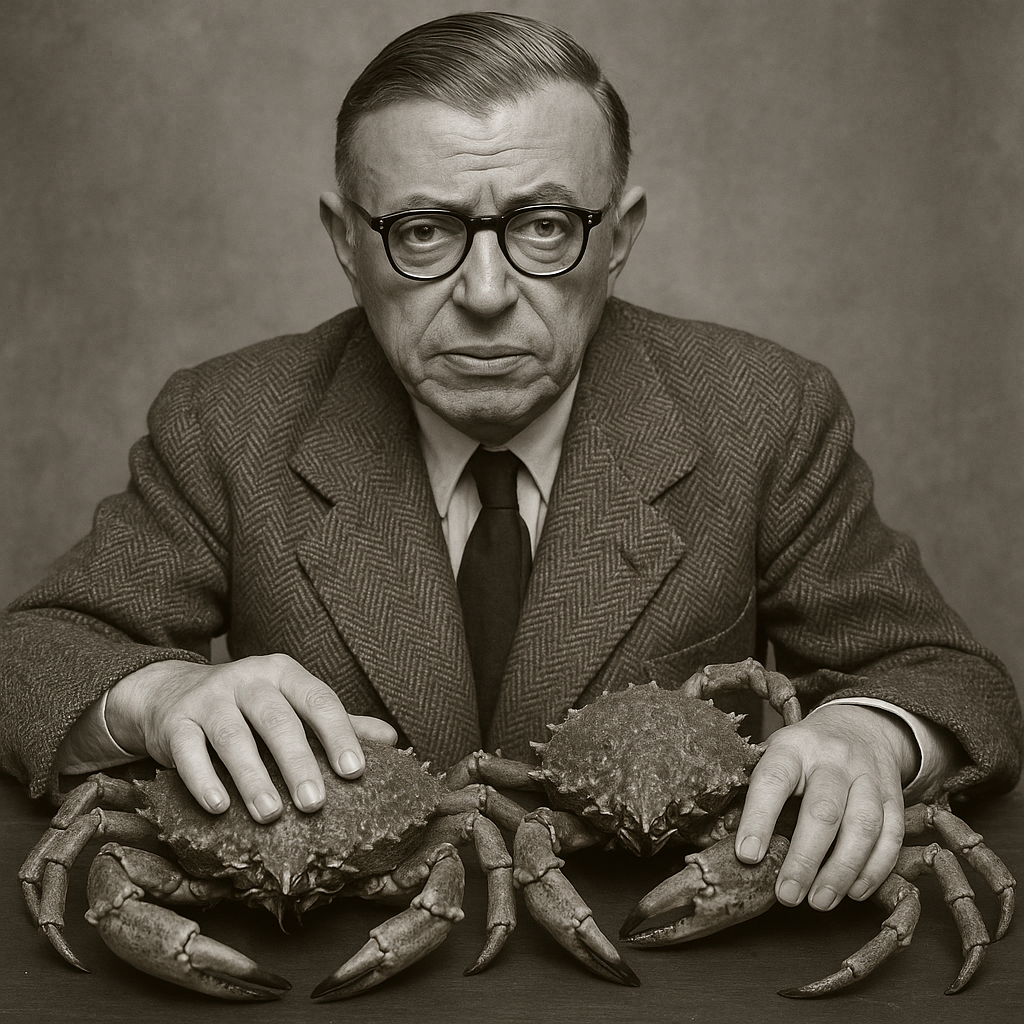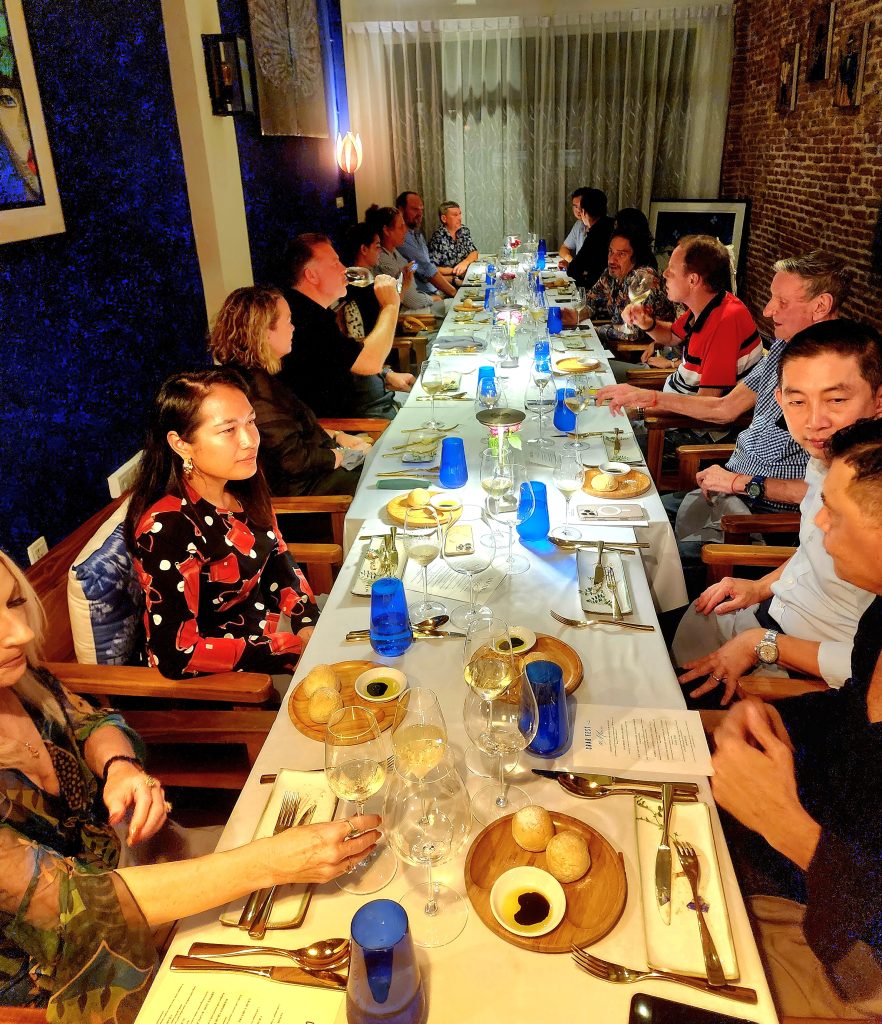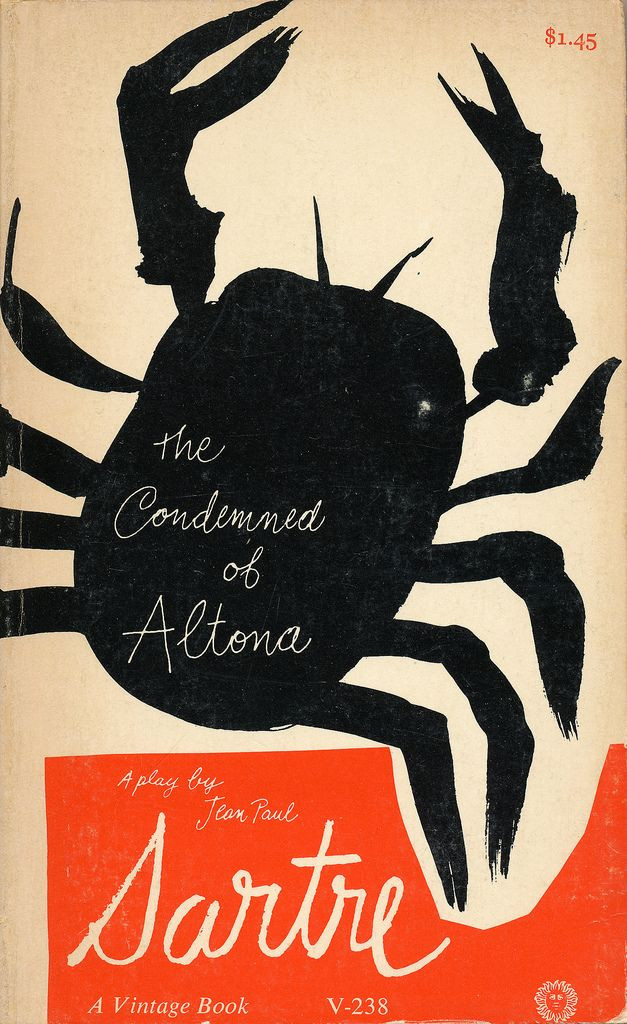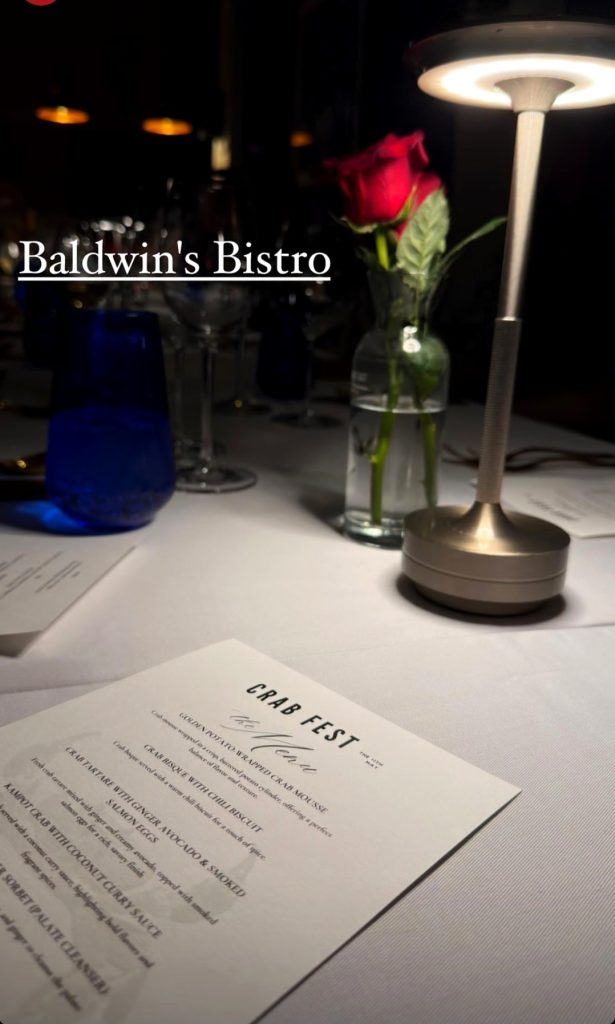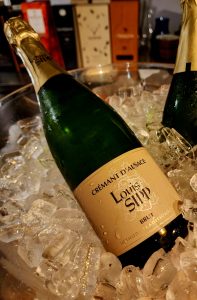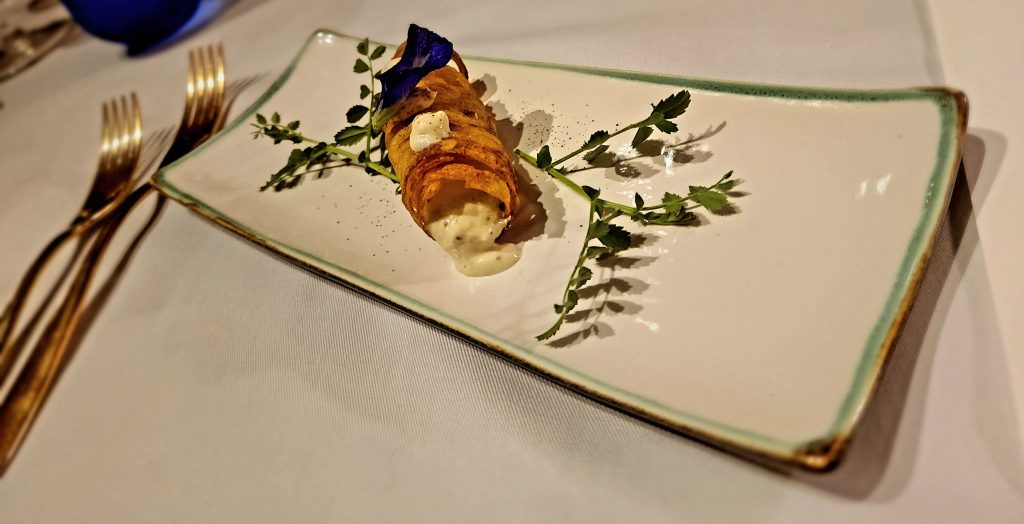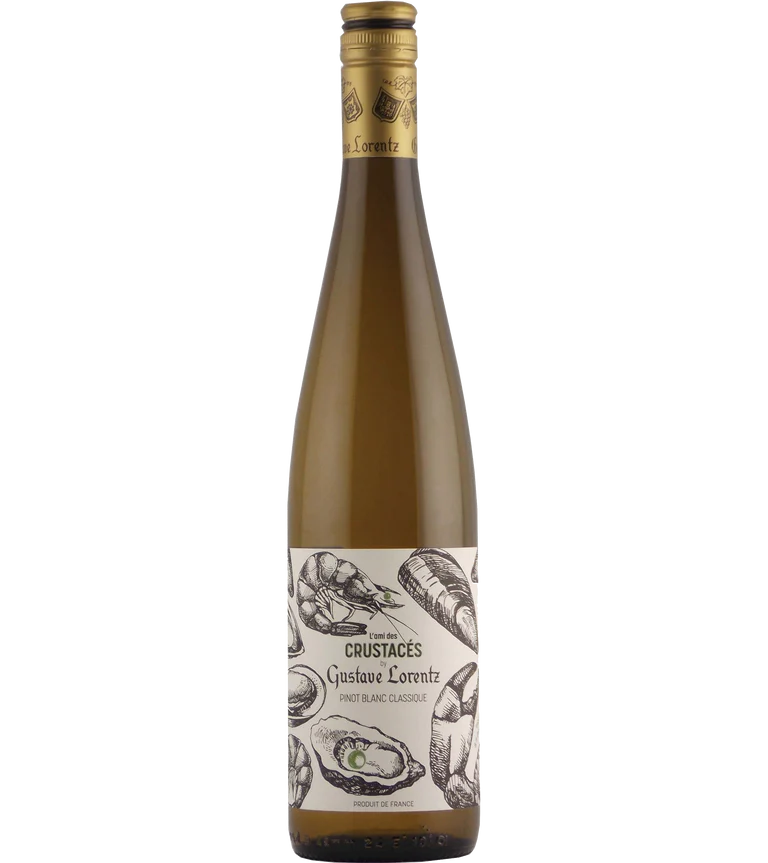“One of the very nicest things about life is the way we must regularly stop whatever it is we are doing and devote our attention to eating.” -Grimod de la Reynière
Crustaceans and Alsatians
One evening, a private room, an outstanding restaurant: eighteen guests, seven delectable courses, eight exceptional wines, one liver-rattling Eau de Vie. Oh, and so many crabs we lost count! Welcome to Crab Fest.
Aristology
Guy Baldwin’s passion for good food and the art of cooking is clearly and most deliciously evident to anyone who dines in his eponymous restaurant. The upstairs private dining room features a single, long table that stretches down the middle of a stylish, rectangular space. Stunning pieces from Develter’s Kaleidoscope series, Koireng Chin Sei I’ hang on its walls. It is just perfect for small events and curated pairings of fine wines with bespoke menus. As an avid aristologist, this conjures up serendipitous opportunities far too delicious not to bring to fruition.
Being & Nothingness
One January evening in 1935, the (then not yet quite) great existentialist philosopher Jean-Paul Sartre, just 30 years old, was at Sainte-Anne Hospital in the 14th arrondissement of Paris. The hospital, built in 1651, specialized in psychiatry, neurology, neurosurgery, neuroimaging, and addiction. Sartre had given much consideration to the experiment before arriving that evening. His lover, the existentialist philosopher, writer, social theorist, and feminist activist Simone de Beauvoir, would later be furious with him for putting his great mind in such reckless jeopardy. To her, he betrayed the underlying principles of what it meant to be an intellectual. Yet here he was, rolling up his sleeve so that his old school friend, the psychiatrist Daniel Lagache, could inject the mescaline.
Travels with my Crustaceans
This was to be an experiment in looking at consciousness in a different way, following Edmund Husserl’s path of phenomenology and ‘to the things themselves’ (zu den Sachen selbst); but it did not work out that way. The experience had a profound effect on the young philosopher, which he touched on in ‘L’imaginaire’, his 1940 study of the phenomenology of the imagination. According to Mike Jay in the Paris Review, Sartre found observing the effects of the drug itself elusive, noting that it existed by stealth and that he ‘had the feeling’ it was sinister in nature. For Sartre, the overall experience was a negative one, but that was just the beginning of his troubles. Simone de Beauvoir wrote about Sartre’s mescaline experience and the dramatic effect it had on him in her 1960 memoir ‘The Prime of Life’. She noted that afterwards, everyday objects would take on menacing shapes and forms. Josh Jones writes in ‘Open Culture’ that “His visual faculties remained distorted for weeks.” Sartre saw houses with “leering faces, all eyes and jaws.” Clock faces took on the features of owls. He confided to de Beauvoir that “he feared one day he would no longer know whether or not these were just hallucinations.”
The experience also seemed to trigger in Sartre an innate fear of crustaceans! He told the political science professor John Gerassi in 1971 that these crabs began to follow him around all the time. He felt it was a nervous breakdown, noting that they followed him into the streets, even into class. “I got used to them. I would wake up in the morning and say, “Good morning, my little ones, how did you sleep?” I would talk to them all the time, or I would say, “OK guys, we’re going into class now, so we have to be still and quiet,” and they would be there, around my desk, absolutely still, until the bell rang.”
Having somehow put up with this for twelve months, Sartre—no longer fearing the crabs, but fearing he was on the verge of a complete psychotic meltdown—went to see his friend, the psychoanalyst and psychiatrist Jacques Lacan. Lacan stated that Sartre revealed to him a long-held fear of sea creatures, especially crabs. It was also noted how prominently writing about crabs had begun to feature in his work, most strikingly in his 1959 play ‘The Condemned of Altona’, where crabs of the thirtieth-century sit in judgment of twentieth-century humanity. Lacan talked later of how the two men concluded this was somehow a fear of becoming alone for Sartre, whose network and camaraderie had begun to fall away. With this realization, the crabs seem to have simply disappeared for Sartre. However, sometimes, when he was feeling particularly low, Sartre would get the sense that they were still there, lurking in the shadows, menacing and just out of sight. Yet still, at other times, he admitted to missing them!
This bizarre episode in the great philosopher’s life prompted writer and storyteller Annalisa Koukouves to ask, “Do the things we fear represent the things we most long for?”
It appeared to Lacan that Sartre had supplanted an unconscious fear of becoming alone with his life-long and conscious fear of sea-creatures.
“Perhaps all the dragons in our lives are princesses who are only waiting to see us act, just once, with beauty and courage. Perhaps everything that frightens us is, in its deepest essence, something helpless that wants our love.”— Rilke, Letters to a Young Poet
ACT ONE
Crémant d’Alsace, Louis Sipp, Cuvée Assemblage, Alsace France
GOLDEN POTATO-WRAPPED CRAB MOUSSE
Crab mousse wrapped in a crisp, buttered potato cylinder, offering a perfect balance of flavour and texture.
Gustave Lorentz L’ami des Crustacés Pinot Blanc Classique, Alsace France, 2023
Upon arrival, guests were poured a charming Crémant d’Alsace from Louis Sipp. The wine is composed of a blend of Pinot Blanc, Auxerrois, Chardonnay, Pinot Noir, Pinot Gris, and Riesling grapes and has a fine bead, a lovely mousse, and delightful freshness, with notes of white flowers, apple, and citrus. Conversation began to hum as guests made their way upstairs. We were off to a great start.
The first course was an amazing crab mousse wrapped in a crisp, buttered potato cylinder, a rich and creamy texture with the seductive flavours of fresh crab, given a light crunch and texture by the crisp casing to nicely elevate the dish. It was a superb opening number from the chef and a high bar from the very first course of the evening.
The pairing was a 2023 Pinot Blanc from Gustave Lorentz, known as ‘L’ami des Crustacés’ (The friend of crustaceans). Could there be a more appropriately named wine to be the first pairing? The Lorentz family have been in the commune of Ribeauvillé at least since the end of the Thirty Years’ War in the second half of the 17th century. They were innkeepers, coopers, and ‘gourmets,’ the old name given to wine merchants at that time. In the late 1800s, Gustave Lorentz decided to concentrate only on the winegrowing side of the business. Today, the Lorentz family still tends these vines and produces the family wines.
This is an elegant, dry white wine with lovely lime and lemon characters, a touch of wild honey, some beautifully integrated acidity, chalky, with a touch of saline on the finish. It was an inspired and excellent pairing with this dish. I loved the elegance, restraint, and freshness of this wine.
Taste buds tantalised, wine and conversation flowing, we were eager for the next act to begin.
Darren Gall

